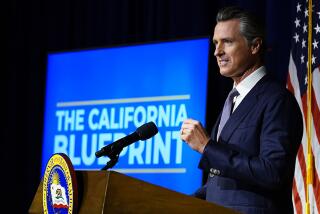Assembly to Begin Wrestling With Wilson Tax-Cut Plan : Amid uncertainties, would slashing 15% be premature?
- Share via
Debate on Gov. Pete Wilson’s proposed 15% personal and corporate tax cut is heating up as the Republican-controlled Assembly prepares to take up the legislation Monday. The Senate, under Democratic control, is expected to oppose the measure. Both camps make strong cases, but at this point strapped city and county governments may need state money more than taxpayers need a break, in large part because Wilson has been so tight with property tax reallocations in his recent budgets.
The move to enact a tax cut seems premature anyway. The governor has not submitted revisions to his proposed 1996-97 budget, leaving the state funding picture unclear. Even more obscure is federal funding for some mandated state programs such as welfare. The seemingly endless budget impasse in Washington will have ramifications down the line. To move now on a tax cut might be too soon, perhaps even foolhardy in light of the needs of California’s counties and cities.
In 1994 the Governor’s Task Force on California Tax Reform and Reduction, headed by former U.S. Secretary of State George P. Shultz, issued an unfavorable report on the business climate in California. The state was reeling from its worst recession since the Great Depression. The economists said relief was needed to spur recovery, suggesting regulatory and legal reforms and easing taxes. Wilson responded with a proposed 15%, across-the-board tax cut over three years, contending that California’s tax burden was excessive compared to other states and that the state’s competitive position was poor. But the Legislature, then controlled by Democrats, rejected the cut.
The governor resurrected the proposal in the 1996-97 budget, which he announced in January. That $61.5-billion document would pump more money into schools and prisons but make deeper cuts in welfare. The budget also counts on more than $600 million in federal funds for health care and prison costs related to illegal immigration. But will the money be coming from Washington? It’s uncertainties like these that make a tax cut problematic now.
Between July 1995 and January 1996 the state economy rebounded so dramatically that state officials now estimate a budget surplus of at least $1 billion by June.
AB 2033, authored by Jim Brulte (R-Rancho Cucamonga), is Wilson’s proposal to cut personal and corporate income taxes by 15% over three years. In all, the proposed cuts amount to an estimated $10.2 billion in lost state revenues. They would be implemented in increments of 5% starting next year.
According to the state legislative analyst’s office, the governor’s tax proposal would take away more than $6 billion over four years from K-12 school funding. The governor’s office argues that total spending for schools would increase, as it has every year since Wilson took office. But school officials counter that state funds now provide for only bare necessities.
Tax cuts would also mean $4.8 billion less for California’s general fund, according to the legislative analyst’s office. That surely would negatively affect higher education, which competes for funding with other state programs such as prisons.
The economy is rebounding, and that’s good news. Corporate tax cuts could speed the recovery, and personal cuts could ease the pain household to household. But the situation is fluid, so much so that there should be serious question whether this is the time for tax cuts. The Legislature and the governor would do well to address uncertain budgetary assumptions and funding priorities before moving forward.
More to Read
Get the L.A. Times Politics newsletter
Deeply reported insights into legislation, politics and policy from Sacramento, Washington and beyond. In your inbox twice per week.
You may occasionally receive promotional content from the Los Angeles Times.









